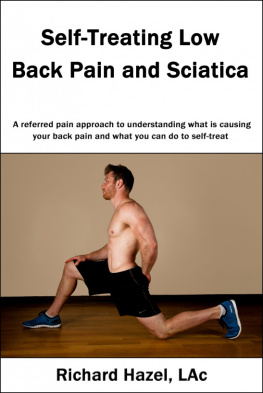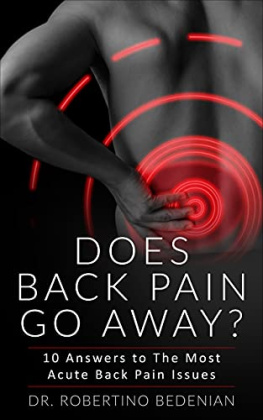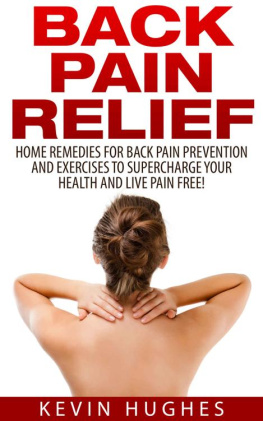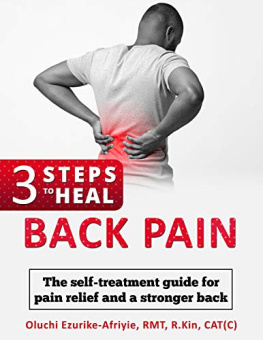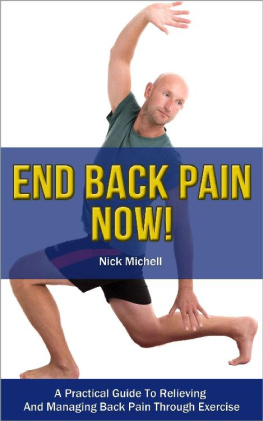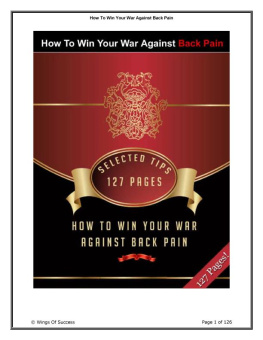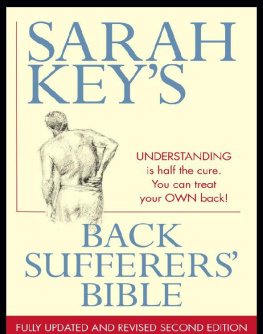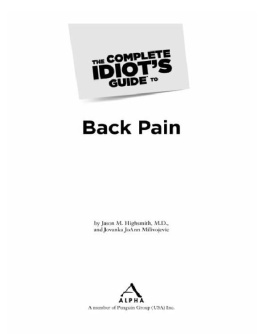TAKE BACK
YOUR BACK
EVERYTHING YOU NEED TO KNOW TO EFFECTIVELY REVERSE AND MANAGE BACK PAIN
BETH B. MURINSON, M.D., PH.D.
Director of Pain Education
Department of Neurology
Johns Hopkins School of Medicine

Text 2011 Beth B. Murinson, M.S., M.D., Ph.D.
First published in the USA in 2011 by
Fair Winds Press, a member of
Quayside Publishing Group
100 Cummings Center
Suite 406-L
Beverly, MA 01915-6101
www.fairwindspress.com
All rights reserved. No part of this book may be reproduced or utilized, in any form or by any means, electronic or mechanical, without prior permission in writing from the publisher.
15 14 13 12 11 1 2 3 4 5
ISBN-13: 978-1-59233-406-3
ISBN-10: 1-59233-406-7
Digital edition: 978-1-61059-377-9
Softcover edition: 978-1-59233-406-3
Library of Congress Cataloging-in-Publication Data
Murinson, Beth B.
Take back your back : everything you need to know to effectively reverse and manage back pain / Beth B. Murinson.
p. cm.
Includes index.
ISBN-13: 978-1-59233-406-3
ISBN-10: 1-59233-406-7
1. BackachePoular works. I. Title.
RD771.B217M867 2010
617.564dc22 2010031796
Book design: Kathie Alexander
Layout: Kathie Alexander
Illustrator: Robert Brandt
Printed and bound in China
The information in this book is for educational purposes only. It is not intended to replace the advice of a physician or medical practitioner. Please see your health-care provider before beginning any new health program.
To Sasha,

CONTENTS
Preface: Not All Back Pain Is Alike
It is obvious to most people that back pain doesnt happen to every person in exactly the same way. Yet much of todays medical literature fails to guide back pain sufferers and the clinicians who care for them through the manifold challenges of recovering from acute back injury and chronic back pain. The most worrisome clinical reports lump all back pain together, urging physicians to attribute a patients complaints to generic low back pain unless certain red flags are identified. Some reports unwisely assume that all conservative treatments are the same and should be equally potent against all forms of back pain. It seems that back pain research is dominated by those who have minimal direct contact with people actually suffering from back pain. This treat-all-back-pain-alike approach deeply disregards the need to apply the best of modern medicine to alleviate the profound suffering caused by specific back problems.
The forces driving the oversimplification of back pain care are system-wide. There are pressures from businesses to minimize back-related absences from work; from ambitious office managers to reduce the duration of medical visits; from pharmaceutical companies to expand the profits from pain-relieving medications; and from insurers who must otherwise reimburse workers for time spent recovering from injury. The overlapping interests of these various groups have fostered the creation of educational symposia. These symposia promote a single perspective on back-injury science showcasing highly-paid experts who perpetuate the notion that the most back pain episodes cannot be precisely diagnosed. They tell the clinicians in attendance that attempting to do so is a waste of valuable clinical effort. The simplistic ideas that pain killers are the only proven treatment, and that the only non-pharmacological intervention that a sensible doctor can make is to urge patients to continue activity at normal levels are the take-home messages. To make matters worse, by oversimplifying the effects of gender on pain processing, these educational symposia often reinforce stereotypes that limit womens access to care.
It is clear from my clinical practice, personal experience, and speaking to people around the country that this approach to back care fails the Reality Test: Insisting that all back pain is the same just doesnt make sense. The spine is a complex structure; in fact, it is a bio-engineering miracle. Composed of bones, ligaments, nerves, and muscles all working together, the spine allows us to stand upright with the advantages of speedy locomotion and sophisticated hand functions. We would never give up the benefits we enjoy from walking upright. And so, each of us must come to terms with the consequences of an upright posture. Routine exercise and diet are not enough; people need enhanced knowledge of their backs and a deeper understanding of how to build a reservoir of strength and attain freedom from pain-imposed limitations.
This book was created as an open guide for people currently suffering from back pain due to non-operable back injury. The purpose was to bring together top science on back pain with both bona fide and evolving approaches to recovering from back injury. Despite hitting some serious notes here in the introduction, the book itself maintains a friendly, optimistic tone. This is because we know that maintaining a positive, proactive stance really does promote better health outcomes. Remind yourself daily that the glass is not only half full, it is half full of a wonderful life-giving liquid with dozens of health benefits. Drink up and go get another! It is my vision that in reading this book, you will find help and a wealth of useful information. You will reinforce existing good habits and get inspired to try new back-healthy activities. This book is the best of everything that I could know, learn, and find to guide people in getting better from back injury. It is here to speed your journey toward a long and happy life without back pain.
Introduction: How to Use This Book
Because your back is central to everything you do, sitting, standing, walking, and even lying down can be problematic when pain strikes. If you have back pain when sitting, it is likely that working at a desk, eating at a dinner table, and driving are next to impossible. Having back pain when standing or walking puts participation in everyday life out of reach. And back pain when lying down is a prescription for insomnia without the aid of powerful drugs. Ring a bell? You may be experiencing problems similar to these or have an important person in your life who suffers from back pain. Whatever your reason for purchasing this book, you are in the right place. This book is written to guide you, your family, and your friends on the journey to a healthy back.
Take Back Your Back is a synthesis of tested methods for improving back pain. The difficult part of this therapy is that it requires an investment of time and energy, by you as well as your support team: family, friends, doctors, nurses, physical therapists, and co-workers. Knowing what to do when back pain is severe will save hours of frustration and disappointment. Even when there is no quick fix, many things can be done to alleviate acute back pain and speed a return to function. I sometimes explain these methods to patients using the name Aggressive Conservative Therapy, but in reality it is most fundamentally about making peace with your back. Repairing, restoring, nurturing, cultivating, strengthening, building, and ultimately healthy enjoyment of the back are all part of this approach.
In Part I, I describe the major causes of back pain, from muscle-related problems to coccydynia. Many structures in the back can be injured and result in pain. There are 12 thoracic vertebrae, 5 lumbar vertebrae, sacral bones, a tailbone or coccyx, over 20 discs, dozens of facet joints, scores of ligaments, 44 nerve roots, many muscles, and hundreds of nerve branches. When several of these structures are injured at the same time, as often happens with a trauma to the back, the pain is amplified. So its often very difficult to identify the exact source of a problem. This book will help you identify your pain and work with your doctor to receive better care.


